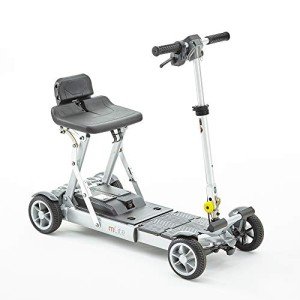10 Mobility Aids Tricks Experts Recommend

Understanding Mobility Aids: Enhancing Independence and Quality of Life
As society continues to age and people significantly look for ways to keep self-reliance, the demand for mobility aids has never been more essential. Mobility aids, which incorporate a variety of devices created to help people with walking or moving around, play a vital function in promoting mobility, boosting safety, and improving total lifestyle. This article will check out the various types of mobility aids, their advantages, factors to consider for choice, and answer some regularly asked questions.
Types of Mobility Aids
Numerous mobility aids are readily available, each designed to attend to particular needs. disabled scooters following table sums up a few of the most common types of mobility aids and their functions.
| Kind Of Mobility Aid | Description | Best Suited For | Key Features |
|---|---|---|---|
| Walking sticks | A portable stick offering assistance and balance. | People who require very little assistance. | Light-weight, portable, adjustable height. |
| Walkers | Four-legged frames providing stability. | Those requiring considerable assistance while walking. | Foldable, some with wheels, included security functions. |
| Rollators | Wheeled walkers with a seat for resting. | People needing mobility with the choice to rest. | Brakes, baskets for personal items, adjustable height. |
| Wheelchairs | Chairs with wheels for individuals with minimal mobility. | Those not able to walk or requiring substantial assistance. | Handbook or powered choices, personalized seating. |
| Scooters | Motorized devices for bigger ranges. | People with limited endurance however needing self-reliance. | Various sizes and designs, often easily transportable. |
| Crutches | Support devices placed under the arms or forearms. | Individuals recovering from lower limb injuries. | Adjustable, lightweight, needs upper body strength. |
| Stairlifts | Mechanical devices for moving in between floorings. | Users facing obstacles in multi-level homes. | Personalized for various staircases, automated. |
Advantages of Mobility Aids
Mobility aids provide a range of advantages that can substantially enhance the lives of people dealing with mobility obstacles. Some significant benefits include:
- Increased Independence: Mobility aids empower people to move easily without depending on others for assistance, consequently improving their confidence and self-esteem.
- Improved Safety: Using mobility aids can lower the threat of falls and injuries, especially for older adults or those with balance issues.
- Enhanced Quality of Life: By assisting in mobility, individuals can take part in social activities, go to events, and delight in life more totally, contributing to much better psychological and mental health.
- Rehabilitation Support: After surgery or injury, mobility aids supply needed support and stability, aiding in healing and rehab processes.
- Availability: Many mobility aids are developed to be utilized both inside and outdoors, ensuring that people can navigate various environments with ease.
Factors to Consider When Choosing Mobility Aids
Picking the suitable mobility help requires mindful consideration of a number of aspects, consisting of:
| Factor | Considerations |
|---|---|
| User's Needs | Evaluate the level of mobility needed; think about whether the user requires short-lived or long-lasting assistance. |
| Physical Limitations | Assess the user's strength, balance, and coordination to figure out the very best type of help. |
| Setting | Think about the main environments where the help will be used, such as home, outdoors, or specific surfaces. |
| Weight and Portability | Guarantee that the chosen device is workable concerning transportability and storage, specifically for outdoor usage. |
| Budget | Mobility aids can be found in a series of prices; think about insurance coverage and offered financing choices. |
| Adjustability | Pick aids that can be changed for height and convenience to accommodate growth or changing needs. |
Regularly Asked Questions About Mobility Aids
1. How do I know if I require a mobility aid?
Many elements can indicate the requirement for a mobility aid, such as trouble strolling or balancing, tiredness while standing, or a current surgical treatment affecting mobility. Consulting with a health care professional can offer assistance customized to individual needs.
2. What types of mobility aids are covered by insurance coverage?
Coverage differs between insurance companies, however most supply options for long lasting medical devices, which generally includes wheelchairs, walkers, and some types of canes. Talk to your insurance provider for specific protection information.
3. Can mobility aids be utilized outdoors?
Yes, numerous modern-day mobility aids are developed for outdoor usage. Rollators, scooters, and some walkers are geared up with functions for stability and ease of use on different terrain.
4. How do I keep my mobility aid?
Routine upkeep includes looking for any wear and tear, guaranteeing that parts such as wheels, brakes, and frames are functioning correctly, and cleaning the equipment as needed. Following the manufacturer's guidelines is important for security.
5. Is there a danger of becoming based on mobility aids?
While some users might end up being reliant on mobility aids, they are created to promote independence and mobility. Slowly utilizing a mobility aid can boost self-confidence and aid maintain physical strength and coordination.
Mobility aids are invaluable tools that empower people to conquer physical obstacles, promoting self-reliance and boosting lifestyle. By comprehending the numerous kinds of mobility aids available, their advantages, and essential factors for factor to consider, households and caretakers can make informed decisions that best meet the requirements of their loved ones. With the best support, those with mobility obstacles can lead satisfying and active lives, totally free to check out the world around them.

